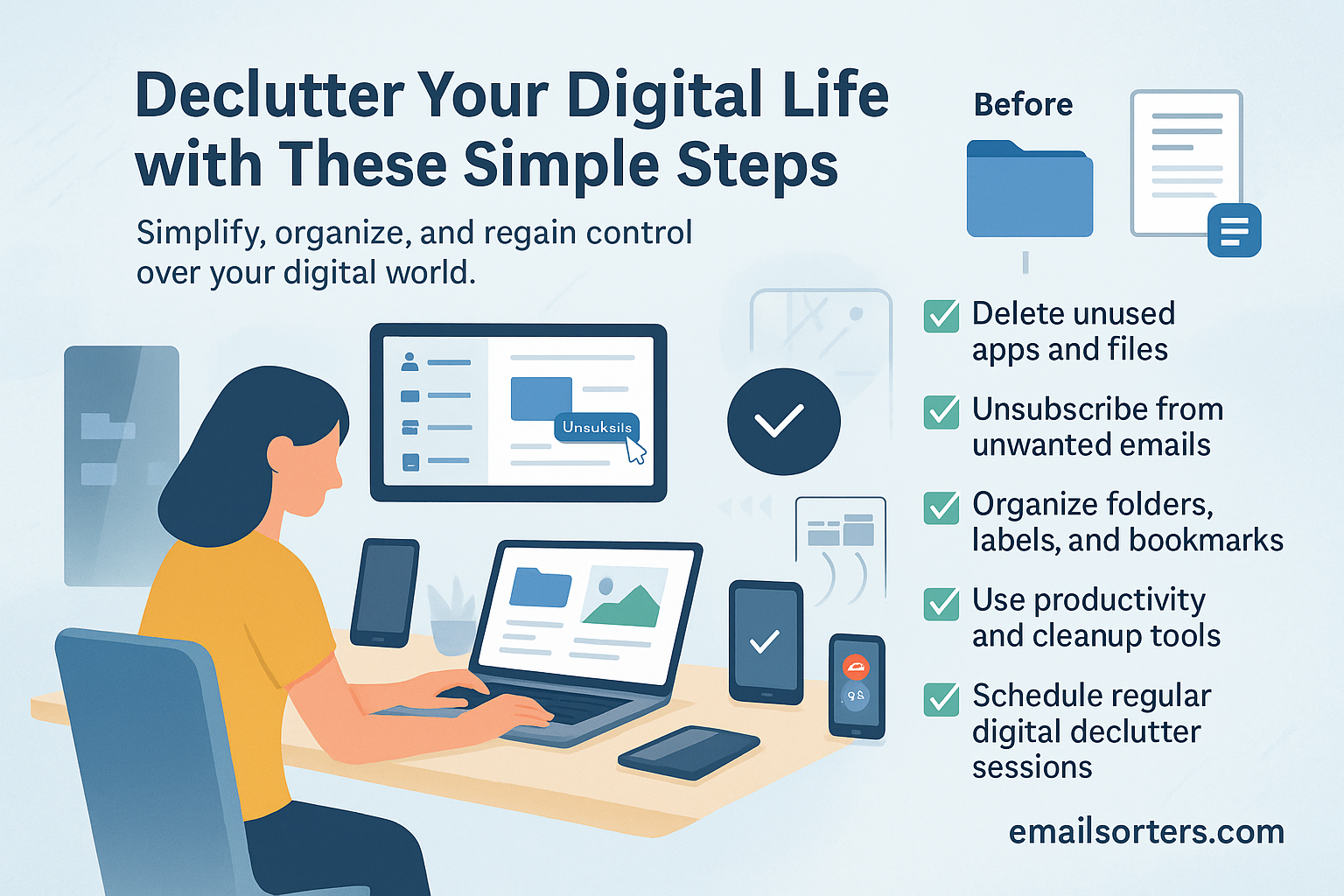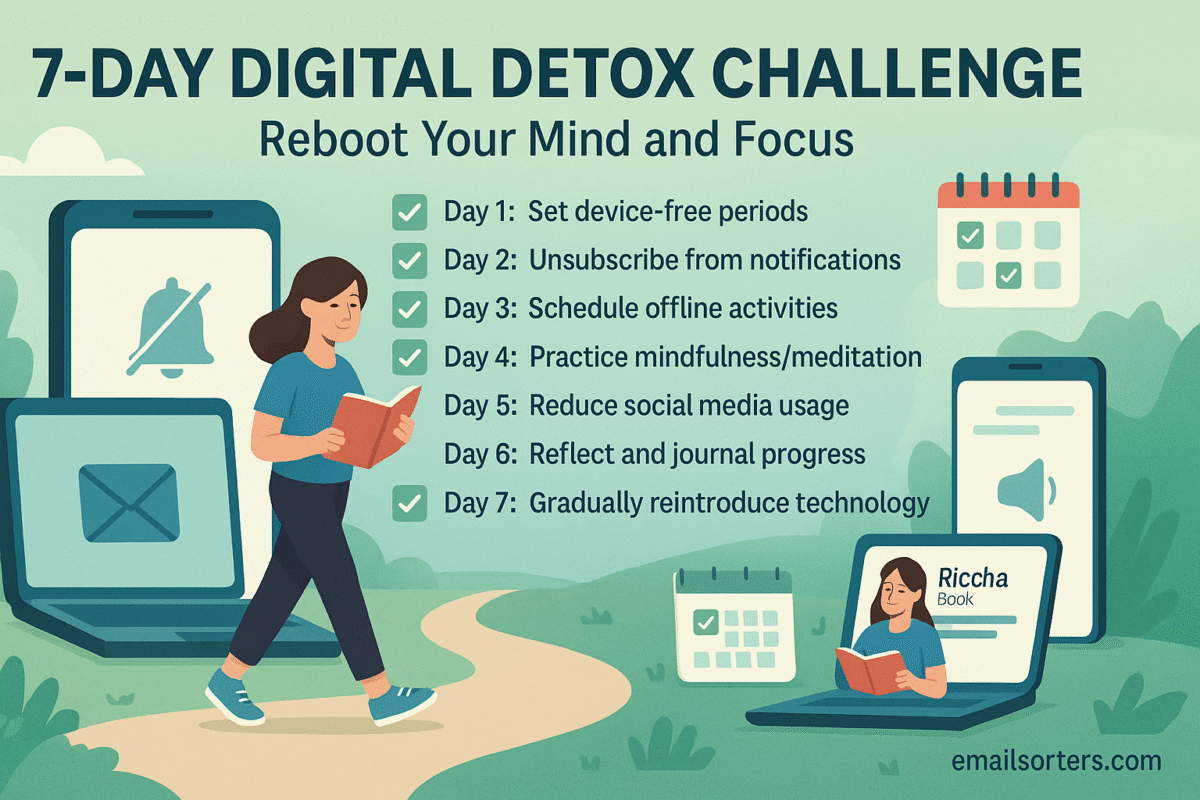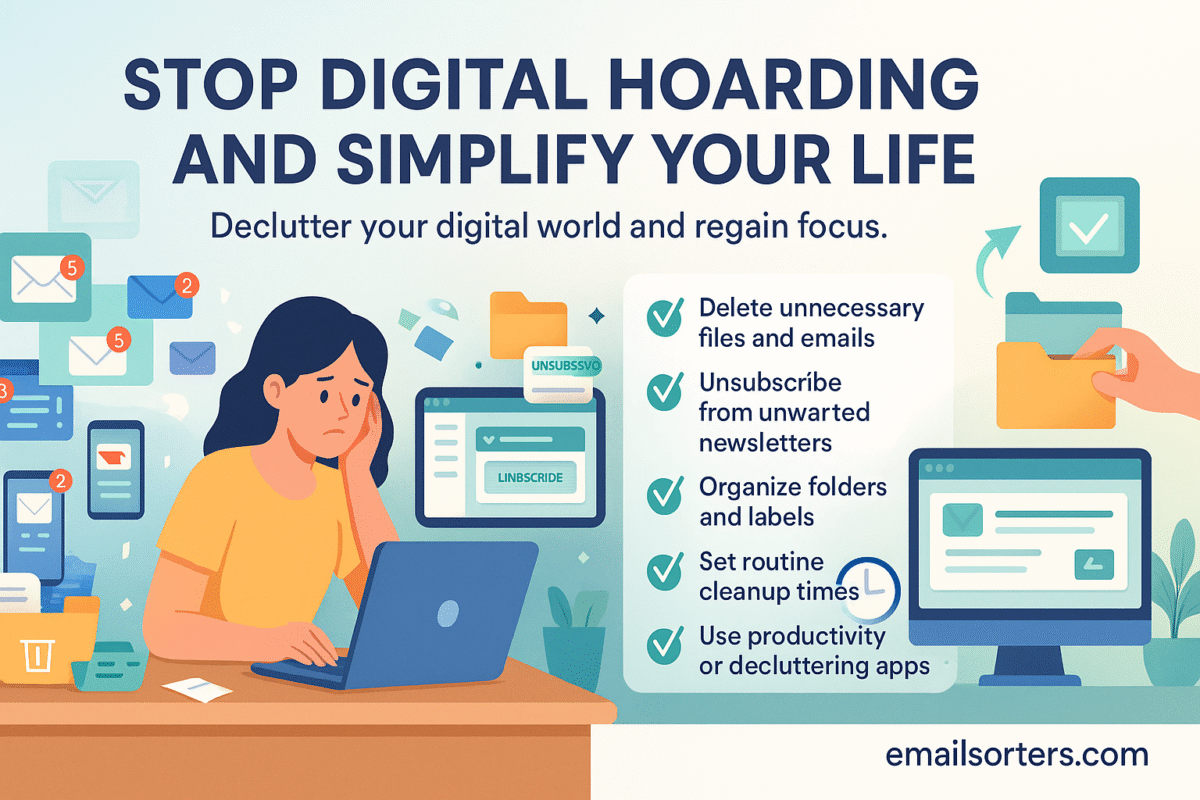Avoid digital distractions sounds simple, but we all know it’s not. You sit down to focus, and suddenly a notification pops up, a quick scroll turns into 20 minutes, or an email pulls you off track. Before you know it, the day feels scattered and unproductive.
The good news? You don’t have to quit technology to stay focused. With a few smart habits and tools, you can cut through the noise, stay on task, and actually finish what you start.
Most of us rely on technology for work, learning, and connection. Yet, the same tools that help us can also steal our focus. Constant notifications, endless scrolling, and multitasking may feel harmless in the moment, but they quietly eat away at time and energy. The good news is that with a clear plan, you can reduce digital distractions and regain control of your productivity.
This guide will break down why distractions happen, how they affect your focus, and what practical steps you can take to stay on track.
Understanding Digital Distractions
What Counts as a Digital Distraction
A digital distraction is anything on a screen that pulls your attention away from your main task. These include:
- Social media updates
- Email notifications
- Text messages or group chats
- Streaming platforms
- News feeds and breaking alerts
- Constant app reminders
While each interruption seems small, the cumulative effect can drastically reduce the amount of meaningful work you get done in a day.
Why Digital Distractions Are So Common
Digital distractions thrive because technology is designed for engagement. Social media platforms, apps, and even emails are built to grab your attention and hold it. Add in the fact that smartphones are always nearby, and you have the perfect recipe for distraction. It’s not about weakness or lack of discipline; our brains are wired to respond to novelty, and technology takes advantage of this.
Signs They Are Hurting Your Focus
If you’re not sure whether digital distractions are affecting you, look for these clues:
- You find it hard to complete tasks without checking your phone or email.
- You often forget why you picked up your device in the first place.
- You feel more tired after a day of multitasking than after focused work.
- Deadlines creep up because you lost track of time online.
- You experience stress when you can’t check your phone immediately.
If these sound familiar, distractions may be taking more from your day than you realize.
The Hidden Cost of Constant Interruptions
How Multitasking Affects Productivity
Many people believe they’re good at multitasking. In reality, switching between tasks reduces efficiency. Every time you stop working to check a notification, your brain needs several minutes to refocus. What feels like quick multitasking is often time loss disguised as productivity.
The Link Between Distractions and Stress
Constant interruptions do more than waste time; they increase stress. Each notification creates a sense of urgency, even if it’s trivial. Over the course of a day, these small stressors add up, leaving you mentally drained. This stress can affect sleep, mood, and even physical health if it continues unchecked.
Time Lost to Digital Interruptions
Research shows that frequent phone checks and app use can add up to several hours per day. Even if each check lasts only a minute or two, the cumulative effect can equal a part-time job. That’s time that could have been spent finishing projects, relaxing, or connecting with loved ones.
The Psychology Behind Distractions
How Technology Hooks Your Attention
Apps and platforms are designed with features like infinite scroll, auto-play videos, and colorful notifications. These tools play into the brain’s craving for novelty. Each new post or message offers a little burst of interest, keeping you engaged far longer than you intended.
The Role of Dopamine in Checking Notifications
Dopamine, a chemical linked to pleasure and motivation, plays a huge role in digital habits. Every time you get a like, message, or update, your brain releases dopamine. This makes you crave more notifications, reinforcing the cycle of checking your phone again and again.
Why Willpower Alone Often Fails
Many people assume they can simply “be stronger” and resist distractions. But willpower is like a muscle; it gets tired the more you use it. That’s why a long day of work often ends in hours of scrolling. The key isn’t to rely only on willpower, but to set up systems and environments that reduce temptation in the first place.
Identifying Your Biggest Distraction Triggers
Work-Related Triggers
For many, work itself creates digital distractions. Constant emails, instant messages, and task notifications can make it hard to focus. Even tools designed for productivity can become sources of constant interruption.
Social and Entertainment Triggers
Social apps, news feeds, and video platforms are some of the biggest culprits. They’re designed to keep you scrolling or watching “just one more.” If you’ve ever planned to check one notification and ended up losing 30 minutes, you’ve experienced this firsthand.
Emotional Triggers That Lead to Scrolling
Distractions aren’t always about the content; they’re often about how we feel. Boredom, stress, and even loneliness can lead to mindless scrolling. The phone becomes a way to escape discomfort instead of dealing with it directly.
Practical Strategies to Reduce Digital Distractions
Turning Off Non-Essential Notifications
Start by reducing the number of interruptions you receive. Turn off alerts for apps that aren’t essential. Keep notifications only for calls or urgent messages. This gives you more control over when you check your phone instead of letting it control you.
Using Time-Blocking for Focused Work
Time-blocking means scheduling specific chunks of time for deep work. During these blocks, silence notifications and keep your phone out of reach. Knowing you have dedicated breaks later makes it easier to stay focused in the moment.
Creating Tech-Free Spaces
Designate areas where technology isn’t allowed. This could be your dining table, bedroom, or home office during certain hours. By setting these boundaries, you create safe zones for focus, rest, and genuine connection.
Building Daily Habits That Support Focus
The Power of Morning Routines
How you start your day shapes your focus. Many people grab their phone as soon as they wake up, flooding their brain with news, emails, and social media before they’ve even had breakfast. This sets a distracted tone that carries into the rest of the day.
A better approach is to design a phone-free morning routine. Examples include:
- Drinking a glass of water and stretching before touching any screens
- Writing down three top priorities for the day
- Reading a few pages of a book instead of checking notifications
- Spending 5 minutes in silence or meditation
When your morning is intentional, you begin the day with clarity instead of distraction.
Taking Intentional Breaks
Breaks are essential for focus, but unplanned ones often turn into long scrolling sessions. Intentional breaks are different; they’re planned and phone-free. During these breaks, do something that recharges your mind:
- Walk outside
- Make a healthy snack
- Do a breathing exercise
- Talk to a colleague or family member
The goal is to refresh your brain without falling into the digital distraction trap.
Replacing Screen Time with Healthier Activities
Cutting back on distractions is easier when you replace the time with something rewarding. If you normally scroll during lunch, bring a book or puzzle instead. If evenings are your weak spot, try activities like:
- Cooking a new recipe
- Practicing a hobby
- Exercising for 20 minutes
- Listening to an audiobook
By replacing screen time with meaningful activities, you reduce the temptation to drift back into old habits.
Digital Tools That Help You Stay on Track
Apps That Block Distractions
Technology can also help reduce distractions. Apps like Freedom, Stay Focused, or Cold Turkey allow you to block specific platforms or websites during work hours. Some even lock you out completely once you’ve hit your daily limit, making it harder to give in to impulse scrolling.
Focus Timers for Deep Work
Using a focus timer; like the Pomodoro technique; helps you work in concentrated bursts. A typical pattern is 25 minutes of work followed by a 5-minute break. During the work phase, put your phone in another room. This structure keeps you focused and reduces the urge to check your device.
Tracking and Reviewing Screen Time
Most smartphones now provide detailed screen-time reports. Review them weekly to see where your time goes. If you notice you’re spending three hours a day on social media, set a goal to cut that to two. Progress becomes easier when you track it regularly.
Training Your Mind for Better Focus
Mindfulness and Single-Tasking
Multitasking feels productive, but it’s usually the opposite. Single-tasking; focusing on one activity at a time; is far more effective. Practicing mindfulness can help with this. When you notice your attention drifting to your phone, pause, take a breath, and gently return to your task. Over time, this retrains your brain to resist distractions.
The Role of Boredom in Productivity
Boredom often drives people to check their phones. But boredom can actually be a powerful tool. It gives your brain space to think, create, and solve problems. Instead of escaping boredom with scrolling, let yourself sit with it. You might find new ideas or solutions bubbling up naturally.
Celebrating Small Wins
Breaking free from digital distractions is a long-term effort. Celebrate small successes, like finishing a full hour of focused work without checking your phone, or going a full evening without social media. Recognizing these wins builds motivation and reinforces the habits you’re trying to create.
Social and Workplace Support
Setting Boundaries with Colleagues
In many jobs, digital distractions come from coworkers; emails, messages, and “urgent” notifications. Set clear boundaries where possible. For example, let colleagues know you check emails at set times instead of responding instantly. This creates expectations that respect your focus time.
Family and Household Agreements
At home, distractions often come from shared spaces. Creating agreements with family members can help. You might decide on “phone-free dinners” or set times when everyone puts devices away. These rules not only reduce distractions but also improve relationships.
Creating Accountability Groups
Accountability makes habits easier to stick with. Partner with a friend or coworker who also wants to reduce distractions. Share weekly progress, set common goals, or even challenge each other with “phone-free hours.” Knowing someone else is on the same journey keeps you motivated.
Handling Setbacks Without Quitting
Accepting Imperfection
Nobody can eliminate distractions completely. There will be days when you slip up and spend more time online than planned. That’s normal. Instead of viewing it as failure, treat it as part of the process. Progress is about trends, not perfection.
Learning from Relapses
When you fall back into old habits, take a moment to reflect. What triggered it? Were you stressed, bored, or overwhelmed? Understanding why it happened helps you prepare for similar moments in the future.
Resetting Quickly After a Slip
The faster you reset, the smaller the setback. Create a simple action plan for when you slip up. For example: put your phone in another room, set a 20-minute focus timer, and dive back into your task. Acting quickly prevents one bad hour from turning into a wasted day.
The Benefits of Cutting Digital Distractions
Improved Productivity at Work
When you reduce digital interruptions, the difference in productivity is striking. Without constant alerts, your brain can stay in deep focus for longer periods. This means you finish tasks faster and with better accuracy. Many professionals report they accomplish in 4–5 hours of focused work what used to take them a full 8-hour day filled with distractions.
Reduced Stress and Better Sleep
Constant screen use; especially late at night; keeps the brain in a state of alertness, making restful sleep difficult. Cutting distractions in the evening allows your mind to wind down naturally. Better sleep not only improves mood and energy but also enhances your ability to focus the next day. Less distraction also reduces stress during the day since you’re no longer pulled in multiple directions.
Stronger Relationships
When you put away your phone during meals, family time, or social gatherings, the people around you notice. They feel valued and listened to. Over time, this strengthens bonds with loved ones and helps you enjoy more meaningful interactions. Relationships thrive when attention is given fully and consistently.
Real-Life Success Stories
Students Who Improved Their Study Habits
One student shared that after deleting social media apps during exam season, their grades went up significantly. Instead of late-night scrolling, they spent evenings reviewing notes and sleeping earlier. The change boosted both their focus and their confidence.
Professionals Who Found Work-Life Balance
A young manager decided to silence non-essential notifications during work hours. Within weeks, they noticed higher productivity and less stress. After work, they turned their phone to “Do Not Disturb,” which helped them enjoy dinners with family without interruptions. Their energy improved, and so did their job performance.
Families Who Strengthened Bonds
One family introduced a simple rule: no phones at the dinner table. At first, it felt odd, but soon conversations grew richer. Their children shared more about school, and the parents realized how much quality time they had been missing before. A small change led to deeper family connections.
Creating a Personalized Focus Plan
Setting Measurable Goals
A vague goal like “spend less time on my phone” is hard to track. Instead, set measurable targets:
- Limit social media use to 30 minutes per day
- Keep work emails closed until 10 a.m.
- Spend the first hour after waking phone-free
Measurable goals make it easy to see progress.
Writing a Daily Routine
Routines reduce decision fatigue. Instead of deciding every moment whether to pick up your phone, you know in advance what your day looks like. A simple routine could be:
- Morning: Phone stays in another room until after breakfast
- Work hours: Time-blocking with phone breaks at lunch
- Evening: Replace screen time with a walk or reading
- Night: Phone off an hour before bed
Reviewing Progress Regularly
Each week, take 10 minutes to check your screen-time reports. Ask yourself:
- Did I stick to my daily limits?
- Which part of the day was hardest?
- What can I do differently next week?
Consistent reviews help you adjust before bad habits return.
Long-Term Maintenance Strategies
Monthly Check-Ins
Set a reminder to review your digital habits monthly. This keeps you aware of creeping distractions. Even small increases in screen time are easier to correct early.
Adjusting Goals When Life Changes
Life events like a new job, moving, or travel can shift your routine. Instead of abandoning your focus plan, adjust it. For example, if your job requires more online time, set stricter evening limits to balance things out.
Keeping Alternatives Ready
Distractions thrive in empty spaces. To avoid slipping back into old habits, keep healthy alternatives nearby:
- A notebook for jotting down thoughts
- A book or e-reader for quick reading
- Simple fitness equipment like resistance bands
- A list of short offline activities (watering plants, stretching, tidying up)
With options ready, you’ll be less tempted to grab your phone automatically.
Conclusion
Avoiding digital distractions isn’t about removing technology from your life; it’s about using it with intention. By setting boundaries, building supportive routines, and replacing screen time with meaningful activities, you gain back hours of focus each week. The benefits reach beyond productivity: you’ll sleep better, feel calmer, and strengthen your relationships.
Remember, the goal isn’t perfection but steady progress. Each small win adds up to a healthier, more focused life.




